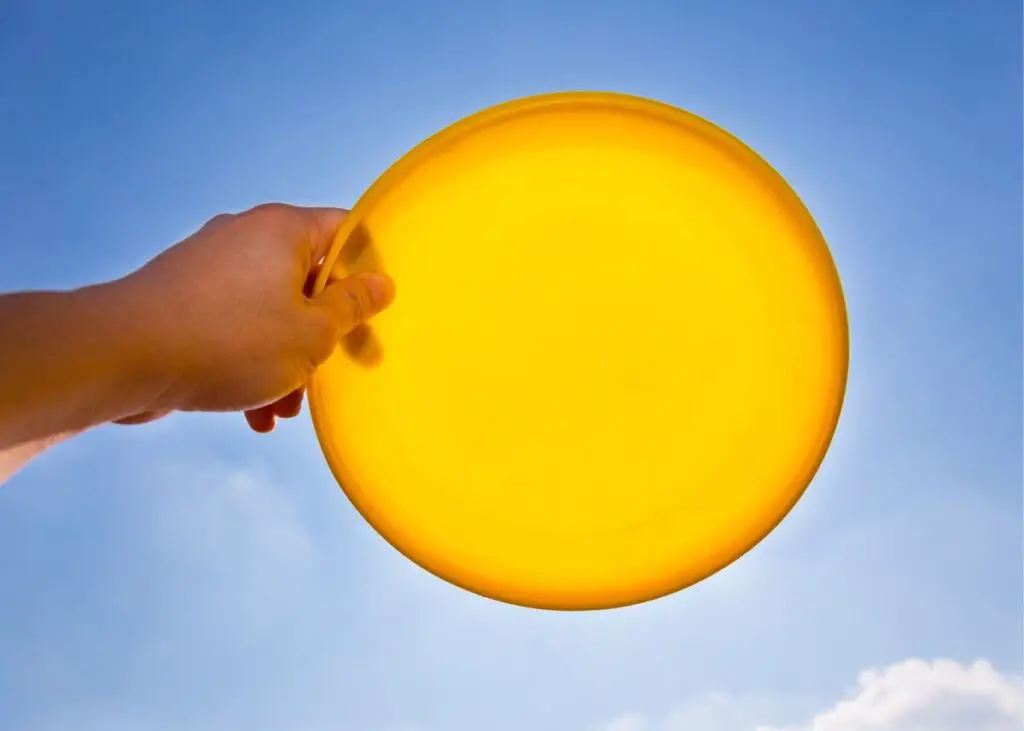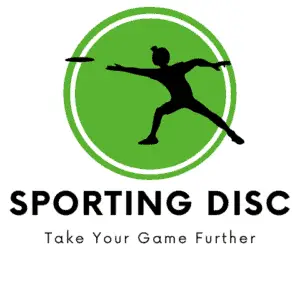Many disc golfers talk about a disc becoming “flippy”. As a beginner, this was a confusing term that seemed like a negative aspect of a disc.
I’ll explain what I eventually discovered about what makes and disc “flippy” and how you can use it to your advantage when playing disc golf.
Table of Contents
Here Is What Makes a Disc Golf Disc Flippy
A disc is considered flippy when it turns in the same direction as the rotation of the disc when thrown. A right-hand backhand throw will rotate in a clockwise direction and naturally fade to the left. A flippy disc will turn with the rotation of the disc and fade to the right.
Below I’ll discuss what makes a disc flippy and why it can be good or bad depending on your needs.

Jargon Buster: Disc Golf Terms to Know First
Hyzer
A throwing angle where the far edge (in relation to the thrower) is pointed down toward the ground. Experienced disc golfers use a hyzer angle to navigate around objects on the course when throwing.
Anhyzer
The opposite throwing angle as the hyzer. The anhyzer release angle will have the far edge of the disc pointed skyward. This release angle will force the disc into an S-shaped flight pattern.
Overstable
Overstable is a descriptive term for the stability of a disc. An overstable disc will always turn in the opposite direction of the spin on the disc.
This means for a right-hand backhand thrower, an overstable disc will fade left when thrown flat.
Understable
An understable disc describes the stability of the disc when thrown. This means that the disc will eventually fade to the right for a right-hand backhand thrower.
Remember that an understable disc will turn with the rotation of the disc.
Roller
A roller is a shot that allows the disc to land on edge and roll on the ground. This can be useful to get more distance from a shot or to avoid obstructions on the course that can’t be thrown around.
A roller shot is best done with a very understable or flippy disc.
RHBH Thrower
RHBH is an acronym for “right-hand backhand”. This is a common throwing technique used in disc golf. From here on, the right-hand backhand will be shortened to RHBH.
What Does It Mean For a Disc To Be Flippy?
To describe a disc golf disc as flippy refers to the stability in flight and the direction the disc will travel when in flight.
A disc that is flippy is going to fade to the right for an RHBH thrower, and in the opposite direction for an LHBH thrower.
These flight characteristics can be useful if you know how to use a flippy disc to your advantage. Generally, disc golf discs are classified as overstable or understable discs when referring to their stability during flight.
Overstable Vs. Understable Golf Discs
Overstable and understable discs have opposite flight characteristics. An overstable disc will fade to the right when thrown by an RHBH thrower. An understable disc will fade to the right for an RHBH thrower.
If you’re thinking of your discs on a scale, the overstable discs fade left, a stable disc flys straight, understable fades right, and a flippy disc is to the right of the understable disc.
An understable disc is commonly referred to as a flippy disc, but they are not always the same thing.
Many players will define a disc as flippy when it easily turns up in the air without putting much of an angle on the throw.
Is a Flippy Disc Good or Bad?
Some players might refer to a flippy disc as being bad or unusable. That’s not always true though. A flippy disc is not a good or bad thing on its own.
It might be to your advantage to have a disc that will turn right when throwing an RHBH shot. Plus, a disc that has been broken in has most likely become more flippy. If you’re very familiar with the flight characteristics of a broken-in disc, this can be a great shot to have in your arsenal.
If you mainly throw RHBH without a forehand shot (which would fade a disc to the right) using a flippy disc is the best way to make a shot that needs to fade to the right.
However, if you’re throwing a flipping disc without the intention for the disc to fade to the right, or even turn to a roller, this can be a bad thing for your game.
How Do I Know If My Disc is Flippy?
If you’re wondering if a disc you’re using is flippy, the best way to know is to throw the disc and see for yourself. Does it flip up and hit the ground as a roller? Does the disc fade to the right hard when thrown RHBH?
These are easy ways to tell if a disc can be considered flippy or not. Here are some reasons why a disc will become flippy.
1. It’s Old and/or Beat In
Every disc golf disc will become what is described as “beat in” or “broken in” over time and use. The disc plastic will become more pliable and less rigid.
This is especially true if the disc has had impacts on other objects, like trees.
It will usually take 6 to 12 months, or even longer for a disc to be broken in. This timeline can vary depending on the use and grade of plastic of the disc.
A disc that is broken in will always trend in the direction of an understable disc. So, an overstable disc that is used for a very long time can eventually end up as an understable disc, or even a flippy disc.
2. It Turns to the Right When Thrown Flat
A good sign that a disc is flippy is when it easily turns right or even flips up when thrown flat.
A normal understable disc can also do this, but this usually happens when it’s thrown as a hyzer. This is when the far edge of the disc is angled toward the ground when thrown.
If the disc is easily turning right on RHBH throws or flipping on edge in the air there is a good chance you have a flippy disc.
3. It Rolls Often When It Lands
A roller shot is when the disc flips in the air, then lands on edge and rolls along the ground. A roller shot can be used strategically when needed.
Players will use a roller to get extra distance from their throws when needed.
A flippy disc might turn into a roller without releasing on an anhyzer angle. A flat release using a flippy disc can result in a roller shot.
Final Thoughts | What Makes a Disc Flippy
While some players will speak of a disc that has become flippy as a negative thing, this is not always true. If you have an understanding of what the disc will do in flight it can be used to your advantage.
Chances are too, that a disc that is well-worn and beat in will be flippy, but you’ll also more than likely have been using that disc for a very long time, and be comfortable with its flight characteristics.
A flippy disc can and should be used in certain situations, and can become an advantage for the player that knows how and when to use their flippy disc.
